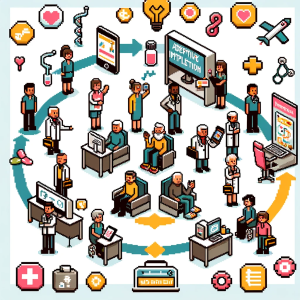
Living Evidence Syntheses: Changing How We Use Research in Public Health
The COVID-19 pandemic shook the world in ways many of us had never experienced before. Aside from its devastating toll on health, the pandemic highlighted a significant issue that often flies under the radar: the massive wave of research being produced—sometimes at a rate so fast it’s difficult to keep up. Public health decision-makers found themselves swimming in an ocean of data, studies, and guidelines, trying to make sense of it all to inform critical policies.
In this whirlwind of information, one tool has emerged: Living Evidence Syntheses (LES). But what exactly is an LES, and how can it help us navigate the flood of research, especially during global health crises like COVID-19? This blog breaks down the basics of LES, explains why they matter, and shows how they can reshape the way public health practitioners and researchers use evidence to inform life-saving decisions.
What Are Living Evidence Syntheses?
LES is essentially a method of continuously updating research evidence on a specific topic. Think of it like your favorite news feed—constantly refreshed with the latest, most relevant information. But instead of scrolling through headlines, LES keeps public health professionals up-to-date with the latest scientific findings. This “living” quality of LES is what sets it apart from traditional evidence syntheses, which are often static and become outdated quickly in a fast-moving world.
During the COVID-19 pandemic, LES became crucial. Public health officials and decision-makers needed to react swiftly to the virus’s evolving science—whether that was related to the effectiveness of vaccines, new treatments, or the impact of social distancing measures. LES provided the perfect tool for this by continually updating summaries of existing research, allowing decision-makers to base their actions on the most current and reliable information available.
Why Do We Need LES Now More Than Ever?
Before COVID-19, the research landscape was already growing exponentially. Scientists were producing more studies than ever, but often with little coordination between them. This led to what experts call “research waste,” where countless studies are done, but only a fraction is truly useful for decision-making. The pandemic accelerated this issue, producing even more studies in a short time.
This avalanche of information challenged decision-makers. They needed a way to quickly understand which findings were robust and relevant to their specific needs. LES came to the rescue by synthesizing and updating evidence in real time. No more waiting months or years for a new guideline based on outdated studies—LES gave professionals the latest information to work with right away.
In essence, LES offers a solution to both information overload and research waste, making sure that scientists’ knowledge doesn’t just sit on a shelf but is applied in real-world decisions that impact public health.
How Do LES Work?
LES follows a structured process to ensure that they remain “alive” and constantly updated. The method starts with a baseline synthesis, a snapshot of the most reliable studies on a given topic. From there, researchers add new studies as they are published, rigorously evaluating them for quality and relevance.
One of the most exciting aspects of LES is its flexibility. Unlike traditional reviews, which may only be updated every few years, LES can be tailored to the needs of decision-makers. If a specific topic—say, vaccine effectiveness—becomes a high priority, LES can focus on frequent updates in that area. This adaptability is crucial in times of crisis when every decision counts.
Additionally, LES isn’t just for emergencies. They can be used in more routine circumstances, ensuring that public health policies are always based on the best available evidence, whether it’s about preventing chronic diseases or managing mental health.
When Should LES Be Produced and Updated?
One key finding from recent research on LES is understanding when they should be initiated and updated. LES is particularly useful when there’s a high degree of uncertainty around a topic and new research is being produced at a rapid pace. COVID-19 is a perfect example, but LES can also be beneficial in areas like climate change, where the science is constantly evolving.
The frequency of updates depends on the volume of new evidence being produced. In fast-moving fields, updates might happen weekly or even daily. In other cases, monthly or quarterly updates might be more appropriate. What’s critical is that these updates happen continuously, not just in response to a crisis. This ensures that public health decisions are always informed by the latest science, not outdated studies.
How Are LES Disseminated?
It’s not enough to produce updated evidence—people need to know about it. That’s why dissemination is a key part of the LES process. LES findings are often made available through platforms like public health databases, specialized websites, or even social media. The goal is to reach decision-makers where they are, ensuring that the latest evidence doesn’t just sit in an academic journal but gets into the hands of those who need it most.
The research also highlights the importance of making LES accessible. Summaries need to be clear, concise, and free of jargon so that anyone—from public health practitioners to policymakers—can easily understand and apply the findings. This focus on accessibility is crucial in ensuring that the evidence reaches beyond academia and into real-world decision-making.
When Should LES Be Discontinued?
Like all good things, LES must eventually come to an end. Knowing when to discontinue LES is just as important as knowing when to start them. The decision often depends on whether new evidence continues to emerge on a topic. If the flow of new research slows or becomes repetitive, it might be time to close the book on an LES.
However, it’s important to note that even when LES are discontinued, their findings don’t just disappear. They remain a valuable resource, providing a snapshot of the best available evidence up until that point. Future researchers and decision-makers can still refer back to them, making them a lasting part of the scientific record.
Join the Conversation
What do you think about the idea of living evidence syntheses? Have you ever struggled to keep up with the flood of research in your field? How do you think tools like LES could help improve public health decision-making in the future?
Let us know your thoughts in the comments below or share your experiences on social media!
Transform Your Knowledge in Minutes!
Our weekly newsletter delivers easy-to-read summaries of the latest public health research. Perfect for busy professionals or anyone who wants to stay informed without the jargon. Subscribe for free and take control of your knowledge today! Click below!



